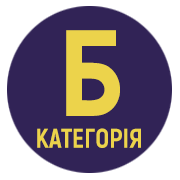DEVELOPMENT OF ARTISTIC COMPETENCE OF HIGH SCHOOL STUDENTS BY MEANS OF REGIONAL ART
Abstract
The article investigates the methodological aspects of the development of artistic competence of adolescent students by means of artistic local history. The author's position is formulated: the art of the native land is an important means of combining world, national and regional artistic cultures; regional art can be an important factor in the development of artistic competence of high school students, which is especially important on the eve of the beginning of independent activity of graduates of general secondary education institutions. Regarding the category of «competence», the authors believe that it is an activated personal experience (knowledge, skills, abilities) that acquires new practical content as the basis for an individual's independent activity. The article substantiates the structure of artistic competence as an intellectual-emotional-activity complex- potential that ensures the ability of a person to understand art, react emotionally to it, and participate in artistic and creative activities. According to the authors, the identification of these components allows differentiating the vectors of pedagogical influence in the process of developing the artistic competence of senior pupils. The following techniques and methods of developing artistic competence are generalized: «discovery», thematic questions, «artistic cipher», «find commonalities» (intellectual component); «sensation, intrigue, mystery», «reincarnation», role-playing (emotional component); reportage photo, dramatization, dramatic sketch, improvisation, etc. (activity component). The examples prove that relying on the principle of artistic local history provides flexible, variable content, affects the intellectual component of artistic competence through students' perception of artistic examples from their living environment, causes an emotionally positive intellectual state of «recognition,» «discovery,» and special attention to a familiar artistic phenomenon. The presence of an artistic example of the native land among the world's outstanding creations evokes a positive emotional response, enriches high (intellectual, moral) feelings, and activates the creative potential of students.
References
Державний стандарт базової і повної загальної середньої освіти. Освітня галузь «Мистецтво». https://zakon.rada.gov.ua/laws/show/1392-2011-%D0%BF.
Словник іншомовних слів. (2000) / уклад. С.М. Морозов, Л.М. Шкарапута. Київ: Наукова думка.
Пометун О. (2004). Теорія та практика послідовної реалізації компетентнісного підходу в досвіді зарубіжних країн. Компетентнісний підхід у сучасній освіті: світовий досвід та українські перспективи. Київ: К.І.С, 16–33.
Масол Л. (2012). Методика навчання мистецтва в основній школі: методичний посібник для вчителів. Київ: Шк. світ.
Зязюн І. (2000). Педагогіка добра: ідеали і реалії: науково-методичний посібник. Київ: МАУП. Масол Л., Гайдамака О. (2010). Художня культура. 10 клас: Тематичні розробки уроків. Харків: Ранок.
Лозниця В. (2000). Психологія і педагогіка: навчальний посібник. Київ: ЕксОб.
Заброцький М. (2002). Основи вікової психології: навчальний посібник. Тернопіль: Навчальна книга – Богдан.
Масол Л. (2019). Нова українська школа: методика навчання інтегрованого курсу «Мистецтво» у 1–2 класах на засадах компетентнісного підходу. Київ: Ґенеза.
Прокопчук В. (2019). Мистецьке краєзнавство як чинник національно-патріотичного виховання майбутніх педагогів. Молодь і ринок, 12 (179). 64 – 69.
Ковальчук В. (1994). Календарно-обрядові пісні Рівненщини. Рівне: Державне редакційно-видавниче підприємство.
Бендюк М. (2012). Історія та легенди давнього Острога. Острог.





